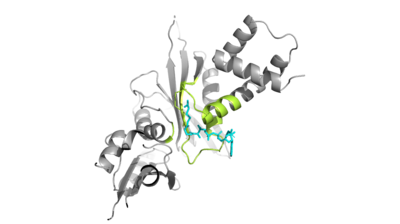User:Caitlin Marie Gaich/Sandbox1
From Proteopedia
(Difference between revisions)
(Undo revision 3026225 by Caitlin Marie Gaich (Talk)) |
|||
| Line 12: | Line 12: | ||
Hat1 is not catalytically active until it binds with HAT2 to form the <scene name='81/811718/Hat1_hat2_complex_aco_and_h4/1'>complex</scene>. HAT1 structure includes 317 residues and is identified as <scene name='81/811718/Hat1_protein/1'>chain A</scene>. HAT2 is identified as <scene name='81/811718/Hat2_protein/1'>chain B</scene>, which includes 401 residues. The activated complex acetylates residues in the 38 residue span of <scene name='81/811718/Portion_of_histone_4/1'>Histone 4</scene>. | Hat1 is not catalytically active until it binds with HAT2 to form the <scene name='81/811718/Hat1_hat2_complex_aco_and_h4/1'>complex</scene>. HAT1 structure includes 317 residues and is identified as <scene name='81/811718/Hat1_protein/1'>chain A</scene>. HAT2 is identified as <scene name='81/811718/Hat2_protein/1'>chain B</scene>, which includes 401 residues. The activated complex acetylates residues in the 38 residue span of <scene name='81/811718/Portion_of_histone_4/1'>Histone 4</scene>. | ||
| - | The HAT1 and HAT2 interface is stabilized by hydrogen bonds, <scene name='81/811717/Salt_bridges/1'>salt bridges</scene>, and hydrophobic interactions. Most of these interactions are located in LP1 of the HAT1 domain, which forms a well-ordered helix. There are three major areas where hydrogen bonds are present. The side chain atoms of <scene name='81/811717/Tyr199_asp308_ala202/5'>Tyr199 and Asp308</scene> with the main chain nitrogen of Ala202 in HAT1. The side chain of <scene name='81/811717/Lys211phe205_and_leu288arg282/7'>Lys211 and Arg282</scene> makes hydrogen bonds with Leu288 and Phe205 respectively. The last area of hydrogen bonds between HAT1 and HAT is found between <scene name='81/811717/Serine_hydrogen_bonds/3'>Ser263 and Asp 206</scene>. The <scene name='81/811717/Hydrophobic_core/2'>hydrophobic core</scene> at the interface of the complex appears to be critical for the complex formation. This core consists of aromatic amino acids from HAT1 and leucine amino acids from HAT2, however it does not form any obvious ring stacking. | + | The HAT1 and HAT2 interface is stabilized by hydrogen bonds, <scene name='81/811717/Salt_bridges/1'>salt bridges</scene>, and hydrophobic interactions. Most of these interactions are located in <scene name='81/811717/Lp1/1'>LP1</scene> of the HAT1 domain, which forms a well-ordered helix. There are three major areas where hydrogen bonds are present. The side chain atoms of <scene name='81/811717/Tyr199_asp308_ala202/5'>Tyr199 and Asp308</scene> with the main chain nitrogen of Ala202 in HAT1. The side chain of <scene name='81/811717/Lys211phe205_and_leu288arg282/7'>Lys211 and Arg282</scene> makes hydrogen bonds with Leu288 and Phe205 respectively. The last area of hydrogen bonds between HAT1 and HAT is found between <scene name='81/811717/Serine_hydrogen_bonds/3'>Ser263 and Asp 206</scene>. The <scene name='81/811717/Hydrophobic_core/2'>hydrophobic core</scene> at the interface of the complex appears to be critical for the complex formation. This core consists of aromatic amino acids from HAT1 and leucine amino acids from HAT2, however it does not form any obvious ring stacking. |
Revision as of 13:05, 11 April 2019
Histone Acetyltransferase HAT1/HAT2 Complex, Saccharomyces cerevisiae
| |||||||||||

